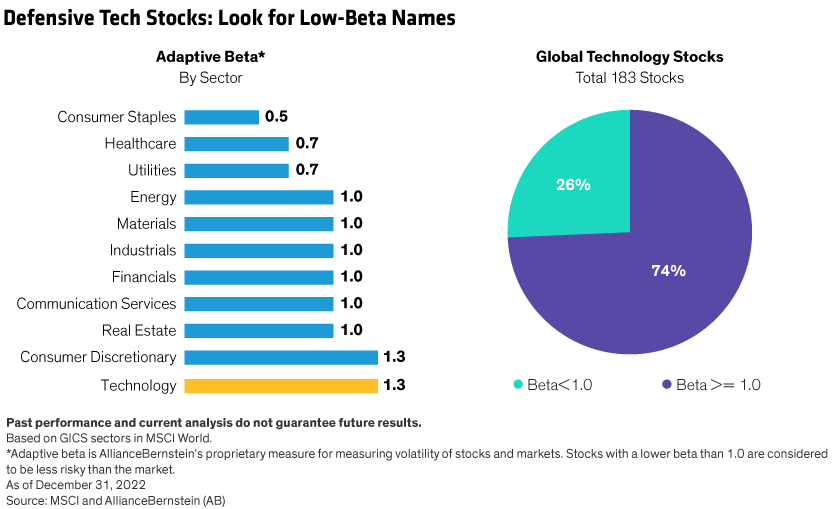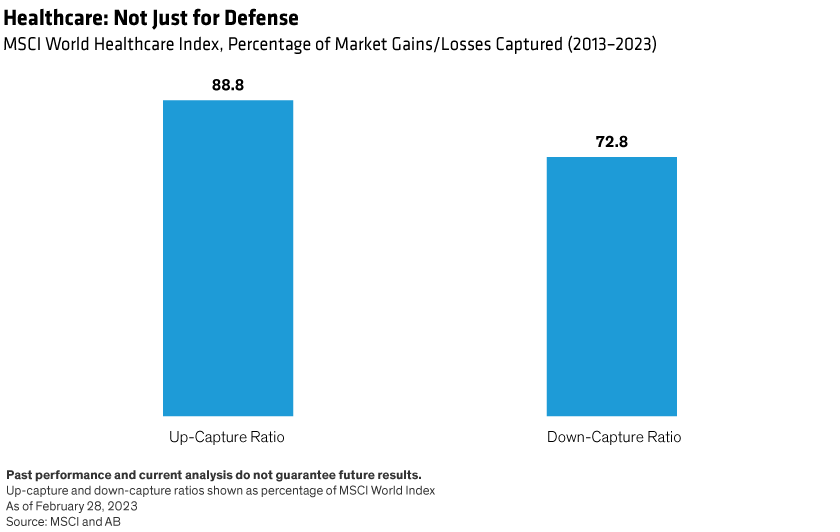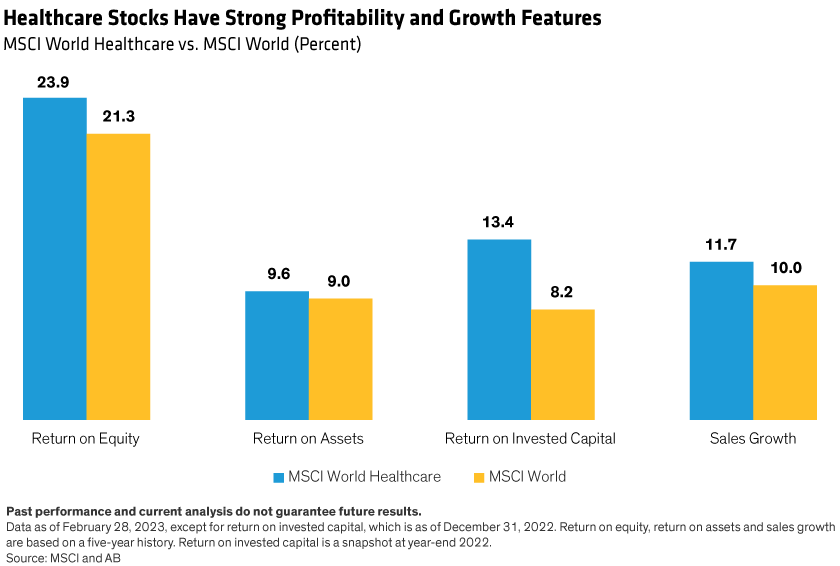Written by: Kent Hargis and Vinay Thapar
Investors tend to have deeply engrained beliefs about what performs best in various market conditions—often for good reason. But sometimes, common knowledge becomes obsolete. Technology and healthcare are good examples of sectors that can play different equity-allocation roles than you might expect.
Typically, the information technology sector is a bellwether of bullish market sentiment. When growth stocks are in favor, technology blue chips have historically offered up supersized returns, albeit with volatility and downside risk to match.
Technology’s reputation as an offensive juggernaut with a shaky defense is in part due to the FAANG (Facebook, Apple, Amazon, Netflix and Google) stocks, which have dominated tech-sector returns in recent years. But last year’s market nosedive underscored the downside of big tech shares, which badly lagged the broader market even as stocks suffered their worst performance since the global financial crisis in 2008–2009.
The FAANG phenomenon, paired with the rise and fall of unprofitable tech firms, has left the impression that technology stocks play poor defense. What do we mean by this? Traditionally defensive shares may not offer the same growth potential but have less downside capture—meaning, they fall less than the market in downturns. Along with utilities and consumer staples, healthcare has long been considered one of the most reliably defensive sectors, providing an important buffer when markets turn sour. That’s because demand for medical care is relatively inelastic. Hospitals, pharmaceutical firms, medical-device manufacturers and medical insurers can generate solid revenue regardless of economic fluctuations.
Technology: Going on the Defensive
But the conventional wisdom around offense and defense is beginning to shift.
Within technology, FAANGs may be the divas—glamorous but temperamental—and unprofitable tech firms haven’t done the sector any favors. Still, there are many high-quality, profitable technology companies that operate behind the scenes with none of the sturm und drang of the big stars. These are the computer hardware manufacturers, payment services firms, cloud computing providers and chip makers that serve as the backbone of the information-based economy and permeate our daily lives. While not showy, these reliable stalwarts have sustainable business models and large, recurring revenue streams.
Owing to their ability to cushion against big price swings, these higher-quality technology enablers outperformed the information technology sector as a whole in 2022. That’s due in part to their lower sensitivity to the broader market—their lower beta—than the big tech names. In fact, roughly one-quarter of the MSCI World Index technology stocks have a beta of less than 1.0, putting them in the same universe as traditionally defensive stocks (Display).

The benefits don’t end there. Unlike income-oriented defensive sectors, which are sensitive to changes in interest rates, some of the highest-quality low-beta technology names may buffer against rising rates because of their relatively low debt burdens.
Healthcare: A Jack of All Trades?
But it’s not just technology that’s shedding its old identity. Healthcare, too, is outgrowing its traditional role as a defensive play.
Granted, it’s still good at containing the damage when markets go south.
In an otherwise brutal year for equity investors, healthcare stocks in 2022 provided the stability that we’d expect of a defensive sector. Global healthcare shares finished the year down 5.4% in US dollar terms, outpacing the MSCI World by more than 12 percentage points. This continues a trend seen over the past two decades in which healthcare has consistently outperformed in down markets.
What may come as a surprise, though, is that healthcare stocks also outpaced the global index even when stocks rebounded in the fourth quarter of 2022. In this way, they provided a level of offense that is not usually expected of a defensive sector. In fact, over the past 10 years, healthcare has captured around 90% of the upside of broad global markets (Display).

What’s behind this shift? In a word: innovation.
The Healthcare Technology Transformation
The healthcare sector is in the early stages of what can best be described as a technological revolution. Emerging technologies are transforming how drugs are manufactured, allowing pharmaceutical firms to profitably personalize treatments, even for rare diseases. Beyond pharma, telehealth and robotics are changing how surgical procedures are conducted, while innovative diagnostics and emerging life-science tools make it possible to identify diseases at an earlier stage.
This technological revolution is bolstering the growth characteristics of healthcare companies, which have provided strong growth and profitability metrics compared to broad global indices (Display).

In keeping with this trend, biotech has become a larger component of most healthcare allocations. But biotech can be volatile, so stock selection is key. Ultimately, we believe that investors are best served focusing on solid business models—not trying to predict science. Rather than making big bets on a company’s drug pipeline, which is notoriously hard to predict, we think it’s better to look for companies with high or improving returns on capital and strong reinvestment capabilities.
In a world where online search firms are wading into healthcare and healthcare software is at the leading edge of technology, it should come as no surprise that old notions of offense and defense are being turned on their ear. Technology stocks can provide surprising stability for a defensive equity portfolio with lower-volatility characteristics, while an allocation to healthcare can offer solid growth potential as well as a cushion in volatile markets. In both sectors, the key to finding consistent sources of returns is to look beyond the flashy headline acts and focus on firms that are quietly and profitably going about their business.



